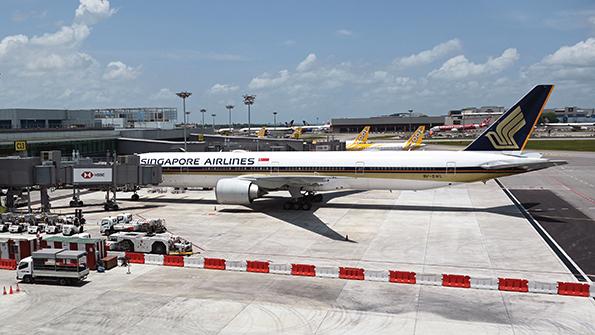
Although international travel recovery remains a distant prospect, some Asia-Pacific countries are looking ahead and developing scenarios for reopening borders. Such road maps will help give the airline industry clarity on how the international market might reemerge when the COVID-19 pandemic finally subsides.
Australia, Singapore and Thailand have revealed their approaches to removing restrictions once vaccination rates reach certain levels. Thailand has already taken the first steps. All three countries have been hit by new COVID-19 outbreaks that have set back their recovery efforts, but they also recognize the importance of laying the groundwork to move to a new normal.
- Countries in the region outline road maps for travel return
- Easing border restrictions relies on reaching vaccination targets
Specific timeline details are yet to be set for the Australia and Singapore plans. However, these two nations and Thailand are some of the key Asia-Pacific aviation markets, so their planning moves may prompt others in the region to follow their example.
One of the common themes among the respective approaches from the three countries is an assumption that COVID-19 will not be eradicated. Rather, its threat can be reduced to the level of other endemic illnesses, thanks to vaccination programs. This will eventually allow the removal of many border and internal restrictions.
In Singapore, a group of three senior government ministers authored a column in the Straits Times on June 24 outlining such a scenario. The ministers, who lead the country’s COVID-19 task force, said a road map to get to this stage was being developed.
In general terms, Singapore’s goal is to reach a point at which mass contact tracing and quarantining every time new infections arise will not be necessary. People who contract the virus could isolate at home, and large gatherings would be allowed. Instead of counting infection numbers, the country would monitor how many people become very sick or require intensive care.
International travel would be allowed under this approach, at least to countries that have similarly controlled the virus and regard it as “an endemic norm,” the ministers said. There will still be a border testing regimen, but travelers—particularly those who are vaccinated—will be able to avoid quarantine if they are tested before departure and again upon arrival.
Government ministers told Singapore’s Parliament on July 26 that an easing of some quarantine rules for vaccinated travelers could occur when vaccination levels reach 80%, which could be achieved by September. But few other specifics of this move or its timing were offered. Singapore has already allowed quarantine-free travel from a few low-risk countries.
Singapore is one of the leaders in the Asia-Pacific region regarding vaccination rates. As of July 24, 72% of the population had received at least one dose, and 52% were fully vaccinated, according to the Our World in Data website. The government expects that at least two-thirds of the population will be fully vaccinated by Singapore’s National Day on Aug. 9.
Australia’s National Cabinet on July 2 agreed in principle to a four-step plan that would gradually ease restrictions on travel to and from Australia. Although the measures in each phase have been described, there is not yet a timeline. The move to each successive stage will be triggered when the vaccination rate reaches a certain level.
As with the Singapore initiative, much work still needs to be done on Australia’s road map. The cabinet agreed to the establishment of a COVID-19 task force that will make recommendations on finalizing this plan, including setting the vaccination targets for each phase.
Australia is currently in the first stage of the proposed process. In this phase, the focus is still on suppressing the virus to minimize community transmission. Entry into the country is heavily restricted, and quotas apply to arrivals who must quarantine. Arrivals from New Zealand are theoretically exempt under a travel bubble arrangement, although this has been suspended for some routes.
In a major change revealed as part of the new road map, the arrivals quota was halved from July 14 until at least Aug. 31. This temporary measure will “reduce the pressure on quarantine facilities, due to the increased risks of the delta strain of the virus,” the Australian government said.
To account for any reduction in flights due to the reduced arrivals quota, the government will fund more repatriation flights and air freight services. Among other new measures in the first phase, trials and pilot programs will be held for alternative quarantine options, such as home quarantine for vaccinated travelers.
The second phase, starting when vaccination rates are higher, will focus on minimizing serious illness and deaths from COVID-19. Inbound passenger caps will be raised, with a higher cap for vaccinated passengers. Quarantine requirements could also be reduced for vaccinated travelers—a step that some other governments such as Hong Kong’s have already taken.
By the third phase of Australia’s plan, COVID-19 will start to be managed in the same way as other infectious endemic illnesses. Caps on returning vaccinated travelers will be abolished in this stage, and all restrictions on outbound travel will be lifted for vaccinated people. At this point, unrestricted travel bubbles can be formed with more countries, such as Singapore and Pacific Island nations. In the fourth and final phase, all inbound vaccinated travelers will be allowed to enter without quarantine. Unvaccinated travelers will be subject to preflight and on-arrival testing.
Thailand is further along with its plan for the gradual resumption of international travel. This is a vital step for the country, which is one of Asia’s leading tourist destinations and heavily reliant on inbound visitors.
Under Thailand’s tourism initiative, some of its popular leisure destinations will progressively open to fully vaccinated international visitors. There is no quarantine requirement under this program, although testing is required. Tourists can travel outside these districts to other parts of Thailand only after 14 days.
The first such destination to open was the island of Phuket on July 1. This was regarded as the pilot program for the reopening plan, and it did succeed in drawing visitors. In the first five days, 32 flights carrying 1,896 tourists landed in Phuket from points in Europe, the Middle East and Asia. The cumulative total rose to nearly 9,000 by July 20. About 100,000 tourists are expected to arrive during the third quarter.
An important component of this plan was a vaccination drive for local Phuket workers and residents. By July 20, 68% of the island’s residents had been vaccinated, close to the goal of 70%.
While the so-called Phuket Sandbox remains open, COVID-19 cases have been surging in many other parts of Thailand. Some additional restrictions have recently been imposed in Phuket until at least Aug. 2. Bars and certain other venues have been closed, and opening hours restricted for many other businesses.
In the second step of Thailand’s phased reopening, tourists were allowed into Ko Samui and nearby islands starting July 15 under similar rules to the Phuket arrangement. The program will be extended to five more leisure travel areas—including Chiang Mai—on Sept. 1, then to Bangkok on Oct. 1 and to the rest of Thailand in October.
Many other important actions are necessary for international travel to reach significant levels in the Asia-Pacific region. For example, more progress is needed on harmonizing vaccination and testing certification, acceptance between countries and border procedures. But looking beyond these issues to outline the post-pandemic travel experience is still a positive step. This will give both the public and industry time to get used to the new concepts, even where setting timelines is not yet viable.





